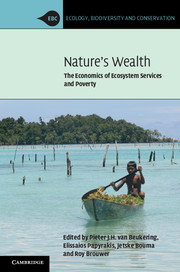Book contents
- Frontmatter
- Contents
- List of contributors
- Acknowledgements
- 1 The economics of ecosystem services and poverty
- Part I Biodiversity-related ecosystem services
- Part II Marine-related ecosystem services
- Part III Forest-related ecosystem services
- Part IV Water-related ecosystem services
- Part V Land-related ecosystem services
- 16 Income poverty and dependence on common resources in rural India
- 17 Tenure security and ecosystem service provisioning in Kenya
- 18 Pastureland degradation and poverty among herders in Mongolia
- 19 Changes in welfare and the environment in rural Uganda
- Index
- References
19 - Changes in welfare and the environment in rural Uganda
Published online by Cambridge University Press: 05 July 2013
- Frontmatter
- Contents
- List of contributors
- Acknowledgements
- 1 The economics of ecosystem services and poverty
- Part I Biodiversity-related ecosystem services
- Part II Marine-related ecosystem services
- Part III Forest-related ecosystem services
- Part IV Water-related ecosystem services
- Part V Land-related ecosystem services
- 16 Income poverty and dependence on common resources in rural India
- 17 Tenure security and ecosystem service provisioning in Kenya
- 18 Pastureland degradation and poverty among herders in Mongolia
- 19 Changes in welfare and the environment in rural Uganda
- Index
- References
Summary
Introduction
The link between poverty and the environment is both context and location specific (Barbier 2000, Chomitz 1999, Ekbom and Bojo 1999). Poverty in remote, inaccessible areas with unfavourable natural conditions often coexists alongside relative affluence in more favourable locations close to major cities and markets. Information on the spatial distribution of poverty and environmental degradation is of interest to policymakers and researchers for a number of reasons. It can be used to quantify disparities in welfare across regions or districts and identify areas that are falling behind. It facilitates the targeting of programmes whose purpose is, at least in part, to alleviate poverty; i.e. programmes related to environmental conservation, education, credit, health and food aid. It may also shed light on the geographic factors associated with poverty, such as degraded forest areas and reclaimed wetlands.
Environmental quality is an important determinant of welfare as it affects health, security, energy supplies and housing quality (Dasgupta and Maler 1995). Typically the relation is quite complex (Roe 1998), but it is clear that especially for poor people environmental quality is a key determinant of welfare as their livelihoods so often depend on natural resource use (e.g. Cavendish 1999, 2000).
- Type
- Chapter
- Information
- Nature's WealthThe Economics of Ecosystem Services and Poverty, pp. 391 - 408Publisher: Cambridge University PressPrint publication year: 2013



